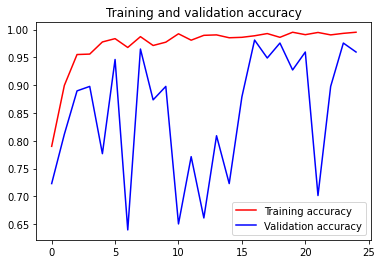Tensorflow: Convolutional Neural Network (P2)
In this blog we’ll continue CNN with transfer learning.
What is transfer learning?
Transfer learning (TL) is a research problem in machine learning (ML) that focuses on storing knowledge gained while solving one problem and applying it to a different but related problem. In this blog, we will transfer the pretrained InceptionV3 model to our Rock-Paper-Scissor classifier.
01: Prepare Data
Same as last blog, download and extract training and validation data.
!wget --no-check-certificate \
https://storage.googleapis.com/laurencemoroney-blog.appspot.com/rps.zip \
-O /tmp/rps.zip
--2020-08-20 11:21:49-- https://storage.googleapis.com/laurencemoroney-blog.appspot.com/rps.zip
Resolving storage.googleapis.com (storage.googleapis.com)... 173.194.76.128, 64.233.184.128, 64.233.166.128, ...
Connecting to storage.googleapis.com (storage.googleapis.com)|173.194.76.128|:443... connected.
HTTP request sent, awaiting response... 200 OK
Length: 200682221 (191M) [application/zip]
Saving to: ‘/tmp/rps.zip’
/tmp/rps.zip 100%[===================>] 191.38M 87.4MB/s in 2.2s
2020-08-20 11:21:51 (87.4 MB/s) - ‘/tmp/rps.zip’ saved [200682221/200682221]
!wget --no-check-certificate \
https://storage.googleapis.com/laurencemoroney-blog.appspot.com/rps-test-set.zip \
-O /tmp/rps-test-set.zip
--2020-08-20 11:22:05-- https://storage.googleapis.com/laurencemoroney-blog.appspot.com/rps-test-set.zip
Resolving storage.googleapis.com (storage.googleapis.com)... 74.125.133.128, 173.194.76.128, 66.102.1.128, ...
Connecting to storage.googleapis.com (storage.googleapis.com)|74.125.133.128|:443... connected.
HTTP request sent, awaiting response... 200 OK
Length: 29516758 (28M) [application/zip]
Saving to: ‘/tmp/rps-test-set.zip’
/tmp/rps-test-set.z 100%[===================>] 28.15M 58.7MB/s in 0.5s
2020-08-20 11:22:06 (58.7 MB/s) - ‘/tmp/rps-test-set.zip’ saved [29516758/29516758]
import os
import zipfile
local_zip = '/tmp/rps.zip'
zip_ref = zipfile.ZipFile(local_zip, 'r')
zip_ref.extractall('/tmp/')
zip_ref.close()
local_zip = '/tmp/rps-test-set.zip'
zip_ref = zipfile.ZipFile(local_zip, 'r')
zip_ref.extractall('/tmp/')
zip_ref.close()
Data augmentation and prepare data generator for model training.
import tensorflow as tf
import keras_preprocessing
from keras_preprocessing import image
from keras_preprocessing.image import ImageDataGenerator
TRAINING_DIR = "/tmp/rps/"
training_datagen = ImageDataGenerator(
rescale = 1./255, # limit the grey value to 0-1
rotation_range=40, # the image can rotate from 0-40 degree
width_shift_range=0.2, #
height_shift_range=0.2, # the image can shift
shear_range=0.2, # the image can shear
zoom_range=0.2, # the image can zoom in and out to at most 20 percent
horizontal_flip=True, # the image can flip horizontally
fill_mode='nearest') # fill blank pixels after processing
VALIDATION_DIR = "/tmp/rps-test-set/"
validation_datagen = ImageDataGenerator(rescale = 1./255) # only augment training dataset
train_generator = training_datagen.flow_from_directory(
TRAINING_DIR,
target_size=(150,150),
class_mode='categorical', # multi-class mode, if two-class use 'binary'
batch_size=126
)
validation_generator = validation_datagen.flow_from_directory(
VALIDATION_DIR,
target_size=(150,150),
class_mode='categorical',
batch_size=126
)
Found 2520 images belonging to 3 classes.
Found 372 images belonging to 3 classes.
02: Build Model From Transfer Learning
In this part, we will use transfer learning to build a bigger and deeper neural network. Firstly let’s download the pre-trained InceptionV3 model including its weights, extract the layers and freeze the weights not being trained later.
from tensorflow.keras.applications.inception_v3 import InceptionV3
# download preloaded weights
!wget --no-check-certificate \
https://storage.googleapis.com/mledu-datasets/inception_v3_weights_tf_dim_ordering_tf_kernels_notop.h5 \
-O /tmp/inception_v3_weights_tf_dim_ordering_tf_kernels_notop.h5
local_weights_file = '/tmp/inception_v3_weights_tf_dim_ordering_tf_kernels_notop.h5'
# load pre-trained model
pre_trained_model = InceptionV3(input_shape = (150, 150, 3), # corresponds with our data
include_top = False, # cut last FC layer, to be replaced by ours
weights = None) # clear weights
# load weights
pre_trained_model.load_weights(local_weights_file)
# lock (freeze) the pre-trained layers
for layer in pre_trained_model.layers:
layer.trainable = False
# pre_trained_model.summary()
# get the last layer of pre-trained layers from summary()
last_layer = pre_trained_model.get_layer('mixed7')
print('last layer output shape: ', last_layer.output_shape)
last_output = last_layer.output
--2020-08-20 11:38:31-- https://storage.googleapis.com/mledu-datasets/inception_v3_weights_tf_dim_ordering_tf_kernels_notop.h5
Resolving storage.googleapis.com (storage.googleapis.com)... 64.233.167.128, 74.125.71.128, 74.125.140.128, ...
Connecting to storage.googleapis.com (storage.googleapis.com)|64.233.167.128|:443... connected.
HTTP request sent, awaiting response... 200 OK
Length: 87910968 (84M) [application/x-hdf]
Saving to: ‘/tmp/inception_v3_weights_tf_dim_ordering_tf_kernels_notop.h5’
/tmp/inception_v3_w 100%[===================>] 83.84M 29.7MB/s in 2.8s
2020-08-20 11:38:34 (29.7 MB/s) - ‘/tmp/inception_v3_weights_tf_dim_ordering_tf_kernels_notop.h5’ saved [87910968/87910968]
last layer output shape: (None, 7, 7, 768)
Now we can build our model by extending the pretrained InceptionV3 model
from tensorflow.keras.optimizers import RMSprop
# Flatten the output layer to 1 dimension
x = tf.keras.layers.Flatten()(last_output)
# Add a fully connected layer with 1,024 hidden units and ReLU activation
x = tf.keras.layers.Dense(1024, activation='relu')(x)
# Add a dropout rate of 0.2
x = tf.keras.layers.Dropout(0.4)(x)
# Add a final sigmoid layer for classification
x = tf.keras.layers.Dense(3, activation='softmax')(x)
# build final model with pre-trained layers
model = tf.keras.Model( pre_trained_model.input, x)
# compile model
model.compile(optimizer = RMSprop(lr=0.0001),
loss = 'categorical_crossentropy',
metrics = ['accuracy'])
03: Training and Visualization
history = model.fit(train_generator, epochs=25, steps_per_epoch=20, validation_data = validation_generator, verbose = 1, validation_steps=3)
model.save("rps.h5") # save the trained model with trained weights
Epoch 1/25
20/20 [==============================] - 25s 1s/step - loss: 0.8723 - accuracy: 0.7901 - val_loss: 0.6861 - val_accuracy: 0.7231
Epoch 2/25
20/20 [==============================] - 23s 1s/step - loss: 0.2579 - accuracy: 0.8996 - val_loss: 0.4400 - val_accuracy: 0.8118
Epoch 3/25
20/20 [==============================] - 23s 1s/step - loss: 0.1293 - accuracy: 0.9552 - val_loss: 0.2386 - val_accuracy: 0.8898
Epoch 4/25
20/20 [==============================] - 23s 1s/step - loss: 0.1577 - accuracy: 0.9560 - val_loss: 0.2649 - val_accuracy: 0.8978
Epoch 5/25
20/20 [==============================] - 23s 1s/step - loss: 0.0580 - accuracy: 0.9778 - val_loss: 0.5463 - val_accuracy: 0.7769
Epoch 6/25
20/20 [==============================] - 23s 1s/step - loss: 0.0473 - accuracy: 0.9837 - val_loss: 0.1699 - val_accuracy: 0.9462
Epoch 7/25
20/20 [==============================] - 23s 1s/step - loss: 0.0927 - accuracy: 0.9679 - val_loss: 1.4277 - val_accuracy: 0.6398
Epoch 8/25
20/20 [==============================] - 23s 1s/step - loss: 0.0383 - accuracy: 0.9873 - val_loss: 0.0920 - val_accuracy: 0.9651
Epoch 9/25
20/20 [==============================] - 23s 1s/step - loss: 0.1102 - accuracy: 0.9714 - val_loss: 0.3521 - val_accuracy: 0.8737
Epoch 10/25
20/20 [==============================] - 23s 1s/step - loss: 0.0711 - accuracy: 0.9774 - val_loss: 0.2828 - val_accuracy: 0.8978
Epoch 11/25
20/20 [==============================] - 23s 1s/step - loss: 0.0233 - accuracy: 0.9925 - val_loss: 1.8297 - val_accuracy: 0.6505
Epoch 12/25
20/20 [==============================] - 23s 1s/step - loss: 0.0572 - accuracy: 0.9810 - val_loss: 0.7946 - val_accuracy: 0.7715
Epoch 13/25
20/20 [==============================] - 23s 1s/step - loss: 0.0363 - accuracy: 0.9897 - val_loss: 1.7787 - val_accuracy: 0.6613
Epoch 14/25
20/20 [==============================] - 23s 1s/step - loss: 0.0295 - accuracy: 0.9905 - val_loss: 0.6368 - val_accuracy: 0.8091
Epoch 15/25
20/20 [==============================] - 23s 1s/step - loss: 0.0473 - accuracy: 0.9853 - val_loss: 1.5680 - val_accuracy: 0.7231
Epoch 16/25
20/20 [==============================] - 23s 1s/step - loss: 0.0386 - accuracy: 0.9861 - val_loss: 0.3479 - val_accuracy: 0.8790
Epoch 17/25
20/20 [==============================] - 23s 1s/step - loss: 0.0295 - accuracy: 0.9889 - val_loss: 0.0689 - val_accuracy: 0.9812
Epoch 18/25
20/20 [==============================] - 23s 1s/step - loss: 0.0186 - accuracy: 0.9929 - val_loss: 0.2031 - val_accuracy: 0.9489
Epoch 19/25
20/20 [==============================] - 23s 1s/step - loss: 0.0441 - accuracy: 0.9861 - val_loss: 0.0779 - val_accuracy: 0.9758
Epoch 20/25
20/20 [==============================] - 23s 1s/step - loss: 0.0164 - accuracy: 0.9952 - val_loss: 0.1721 - val_accuracy: 0.9274
Epoch 21/25
20/20 [==============================] - 23s 1s/step - loss: 0.0264 - accuracy: 0.9909 - val_loss: 0.1407 - val_accuracy: 0.9597
Epoch 22/25
20/20 [==============================] - 23s 1s/step - loss: 0.0131 - accuracy: 0.9948 - val_loss: 2.4778 - val_accuracy: 0.7016
Epoch 23/25
20/20 [==============================] - 23s 1s/step - loss: 0.0258 - accuracy: 0.9905 - val_loss: 0.3103 - val_accuracy: 0.8978
Epoch 24/25
20/20 [==============================] - 23s 1s/step - loss: 0.0157 - accuracy: 0.9933 - val_loss: 0.0650 - val_accuracy: 0.9758
Epoch 25/25
20/20 [==============================] - 23s 1s/step - loss: 0.0188 - accuracy: 0.9952 - val_loss: 0.1025 - val_accuracy: 0.9597
Let’s have a look at the training process, watching how accuracy and loss change over epochs.
import matplotlib.pyplot as plt
acc = history.history['accuracy']
val_acc = history.history['val_accuracy']
loss = history.history['loss']
val_loss = history.history['val_loss']
epochs = range(len(acc))
plt.plot(epochs, acc, 'r', label='Training accuracy')
plt.plot(epochs, val_acc, 'b', label='Validation accuracy')
plt.title('Training and validation accuracy')
plt.legend(loc=0)
plt.figure()
plt.show()

<Figure size 432x288 with 0 Axes>
Absolutely this result is no better than last blog, especially for the validation set. The main reason is that the InceptionV3 model is trained for object classification, but our case is hand gesture, which is not so relative. This is also one big problem in transfer learning to find the relation between different cases. Therefore, instead of using the fixed weights, we can try using them for initialization and let them be trained during the process, which may lead to better results.

Leave a comment